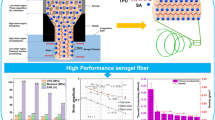Abstract
The subject matter discussed herein relates generally to fabrics composed of micro-denier fibers wherein said fibers are fractured/fibrillated by mechanical means by employing ‘Islands-in-the-Sea’ (I/S) technology instead of the conventional splittable fibers such as segmented pie. More particularly, the present subject matter relates to methods for manufacturing high strength, high surface area, flexible, and durable fabrics through the use of bicomponent fibers fractured mechanically by hydroentangling where the hydroentangling energy is sufficient for separating the fibrils as well as entangling (bonding) the fibers. This paper specifically deals with physical properties of spunbond fabrics consisting of I/S bicomponent fibers. This paper also deals with the bonding energy requirements for fracturing I/S filament. The results for two different polymer combinations (Polyester/Nylon and Nylon/Polyethylene) are discussed below. The influence of different process parameters and fiber characteristics on the physical properties of the fabrics is discussed. The role of the number of islands in the cross-section is also discussed. Finally, the influence of changing the ‘Sea’ polymer on the fabric performance is also discussed.












Similar content being viewed by others
References
Pourdeyhimi B (2008) J Eng Fiber Fabr 3(1):32
Anantharamaiah N, Verenich S, Pourdeyhimi B (2008) J Eng Fiber Fabr 3(3):1
Baker B (1998) Int Fiber J 13(3):26
Cheng KK (1998) Int Fiber J 13(5):40
Grafe T, Gogins M, Barris M, Schaefer J, Canepa R (2001) Nanofibers in filtration applications in transportation. Presented at filtration international conference and exposition of the INDA, Chicago, IL, USA, 3–5 December 2001
Grafe T, Graham K (2003) Int Nonwovens J 12(1):51
Graham K, Gogins M, Schreuder-Gibson H (2004) Int Nonwovens J 13(2):21
Okamoto M (1998) US Patent 4,127,696
Subbiah T, Bhat GS, Tock RW, Parameswaran S, Ramkumar SS (2005) J Appl Polym Sci 96(2):557
Sun Z, Zussman E, Yarin AY, Wendorff JH, Greiner A (2003) Adv Mater 15(22):1929
Bresee RR, Ko W-C (2003) Int Fiber J 12(2):21
Bresee RR, Qureshi UA, Pelham MC (2005) Int Nonwovens J 14(2):11
Li D, **a Y (2004) Adv Mater 16(14):1151
Reneker DH, Chun I (1996) Nanotechnology 7(3):216
Fedorova N (2006) Investigation of the utility of Islands-in-the-Sea bicomponent fiber technology in the spunbond process. Dissertation, Fiber and Polymer Science, North Carolina State University
Fedorova N, Pourdeyhimi B (2007) J Appl Polym Sci 104(5):3434
Pourdeyhimi B (2005) The influence of the number of segments on performance in splittable nonwovens. Presented at the international nonwovens technical conference, St. Louis, MO, September 18–22, 2005
Freudenberg Nonwovens (2007) Weinheim, Germany. http://www.freudenberg-nw.de/ecomaXL/index.php?site=FNW_EN_Hygiene%20Industry. Accessed 22 October 2007
Groten R, Grissett G (2006) Advances made in micro-denier durable nonwovens. Presented at TechTextil North America, Atlanta, Georgia, USA, March 29, 2006
Fedorova N, Verenich S, Pourdeyhimi B (2007) J Eng Fiber Fabr 2(1):38
Nonwovens Co-operative Research Center, The Nonwovens Institute (2009) North Carolina State University, Raleigh, NC. http://www.thenonwovensinstitute.com/product_development_services.html. Accessed 1 June 2009
Anantharamaiah N, Römpert K, Vahedi Tafreshi H, Pourdeyhimi B (2007) J Mater Sci 42:6161. doi:10.1007/s10853-006-1164-7
Acknowledgements
This work was partly supported by a grant from the Air Force Research Labs and the Nonwovens Cooperative Research Center. Their support is gratefully acknowledged.
Author information
Authors and Affiliations
Corresponding author
Rights and permissions
About this article
Cite this article
Durany, A., Anantharamaiah, N. & Pourdeyhimi, B. High surface area nonwovens via fibrillating spunbonded nonwovens comprising Islands-in-the-Sea bicomponent filaments: structure–process–property relationships. J Mater Sci 44, 5926–5934 (2009). https://doi.org/10.1007/s10853-009-3841-9
Received:
Accepted:
Published:
Issue Date:
DOI: https://doi.org/10.1007/s10853-009-3841-9




